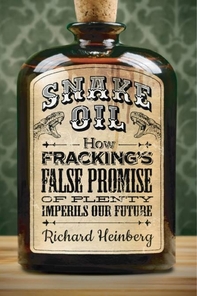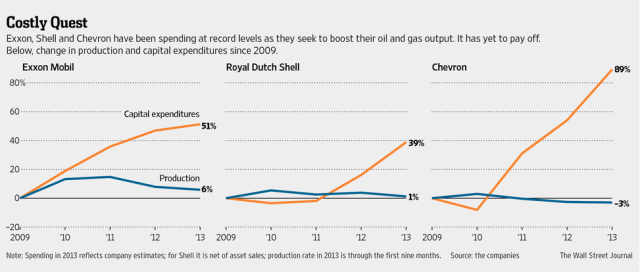David – I thought we were entering an energy “renaissance” with new and easy ways to extract gas via fracking. Obviously, I understand the downsides of fracking. Can you elaborate?
Ken Mann
Whatcom County Councilmember
Yes Ken, I would love to elaborate. Thank you for the question. Councilmember Mann’s note above was in response to my last post: Oil Company Woes: This is What Energy Depletion Looks Like.
Brief recap: In that post I pointed out that many of the big oil companies (the “richest corporations in the history of civilization” according to Pete Kremen) actually are facing some serious cash flow difficulties. How could this be? I pointed to a Steven Kopits presentation at Columbia University showing that the costs of oil extraction have been rising rapidly in recent years, while the price that they’ve been able to sell for has remained fairly flat – about $100 a barrel for the last 3 years. Costs have risen almost 11% per year since 1999, and for oil companies to maintain expected profit ratios, the price should now probably be about $130/barrel or more.
Things are getting so bad that oil companies are cancelling projects, selling assets to pay dividends, and challenging property tax assessments.
Why don’t the oil companies raise the price? Because they don’t set the price, markets do, according to Kopits.
Why doesn’t the market raise the price? Because the economy can’t afford it – prices that high could lead to another recession.
Why are the costs for extracting oil increasing so dramatically?
Here we come back to the concept of energy depletion. “The age of easy oil is over” Chevron CEO Dave O’Reilly told us in an ad campaign in 2005. It turns out he was right. Conventional oil production peaked that year. What has made up the difference since then is unconventional oil sources: ultra-deep water oil, tar sands oil, oil from shale, and oil from fracking. Which leads us to Councilmember Mann’s question:
I thought we were entering an energy “renaissance” with new and easy ways to extract gas via fracking…?
Yes, this is the meme that has been put out there through industry channels. The peak oil community has continually challenged this message. Petroleum geologist Art Berman said “I look at Shale gas more as a retirement party than as a revolution.” Geoscientist Dave Hughes warns that we’re due for the gas bubble to burst in his Drill, Baby, Drill report (summary review here). And Richard Heinberg’s latest book is called “Snake Oil: How Fracking’s False Promise of Plenty Imperils Our Future.”
Lately, even the mainstream media is catching on. Forbes magazine ran a story on Jan. 26th: “Why Shale Oil Boosters Are Charlatans in Disguise.”
It is interesting that this story claims peak oil theory is wrong, but the argument laid out is exactly what the intelligent ‘peak oil’ theorists have been saying for years. This is not new material – it is a simplified version of what’s been said on The Oil Drum peak oil site many times: the importance of getting a significant energy yield for the energy that is invested to get that yield.
The first thing to understand about fracking is that the wells tend to deplete very fast. The second thing to understand about all of these unconventional resources is that it is taking more and more energy to get less and less net energy returned. When you see costs of extraction going up exponentially, that usually means a lot of energy associated with those costs.
We’re already tapped out on the low hanging fruit, and now we’re having to reach further, to dig deeper, to cause more environmental destruction, for less and less of a return. Instead of peak oil, the Forbes article talks about the end of cheap energy, which is fine by me, and perhaps a better way to frame it anyway.
The situation we find ourselves in today is following the trajectory laid out in Heinberg’s 2003 book The Party’s Over, in which he reported the prognosis laid out by geologists Colin Campbell and Jean LaHerrere. As I quoted Heinberg in my last post:
So they were saying back before 2003, because it published in 2003, so it was actually written in 2001 and 2002. So they were saying back in 2000 and 2001 that we would see a peak in conventional oil around 2005—check—that that would cause oil prices to bump higher—check—which would cause a slowdown in economic growth—check. But it would also incentivize production of unconventional oil in various forms—check—which would then peak around 2015, which is basically almost where we are right now and all the signs are suggesting that that is going to be a check-off, too. So amazing enough, these two guys got it perfectly correct fifteen years ago.
A front page story in The Wall Street Journal on January 29th confirms our story about the cash flow struggles the industry is currently facing: “Big Oil Companies’ Big Projects Struggle to Justify Soaring Costs” by Daniel Gilbert and Justin Scheck, Jan. 29th. I think the story is behind a paywall. Someone tweeted the graphic used in the story, which says a lot by itself (Twitter post here.) :
You can see that since 2009 the oil companies have worked very hard to supply the market with oil. The efforts have been compared to The Red Queen in Alice in Wonderland (“Fracking and The Red Queen Syndrome” from Climate Crocks):
The problem is, they can only run in place for so long. As Gail Tverberg pointed out, if the oil companies are now having to cut back on their spending, does this spell The Beginning of The End?
Richard Heinberg and Chris Martenson are right: The Oil Revolution Story Is Dead Wrong.



You need to be a member of Transition Whatcom to add comments!
Join Transition Whatcom